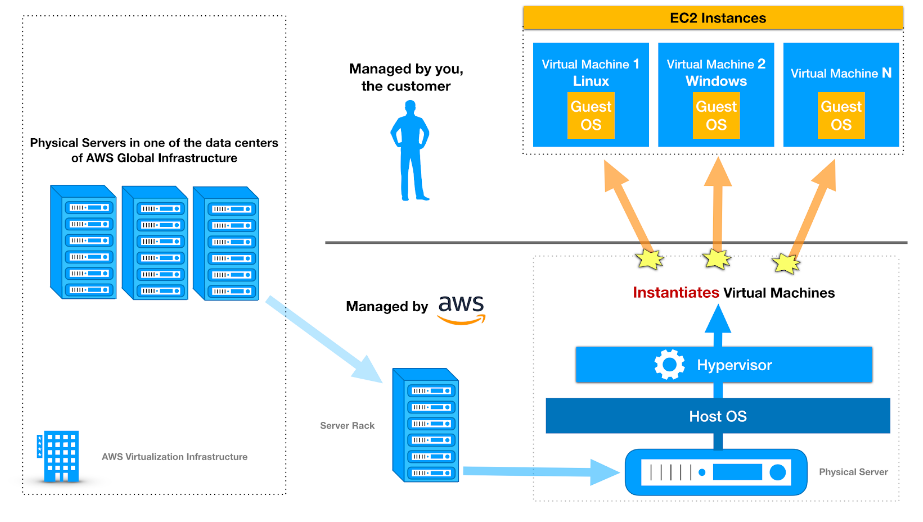AWS Compute Services
AWS provides a variety of cost-effective and flexible computing services to meet the needs of your organization such as Amazon Elastic Compute Cloud (EC2), Amazon Elastic Container Service (ECS), Amazon Elastic Container Service for Kubernetes (EKS), Amazon Lightsail, AWS Batch, and AWS Lambda to name a few. For some services like Amazon EC2, you have extensive control of the underlying resources while for others, AWS has full control.
With these computing services in AWS, you can dynamically provision a number of resources and pay only the computing resources you actually consume. This significantly reduces the upfront capital investment required and replaces it with lower variable costs. Instead of the traditional long-term contracts or up-front commitments, you can opt to pay your compute resources in AWS using an On-Demand or Spot pricing option to easily discontinue your cloud resources if you don’t need them, effectively reducing your operating expenses. Amazon EC2 is a commonly used AWS service which you can integrate with various features and services like Amazon Machine Image, Instance Store, Elastic Block Store, Elastic Network Interface, Elastic IP, Auto Scaling, Elastic Load Balancer, Placements Groups, Enhanced Networking, Security Groups and so much more.
Have you ever heard people say “Amazon Linux EC2 Instance” instead of “Amazon Linux EC2 Server” when they launch a compute resource in AWS? It is because AWS is programmatically creating a new virtual machine (VM) instance, rather than providing you with an actual physical server, when you launch an EC2 Instance. AWS has a powerful virtualization infrastructure that is composed of physical servers that they manage. Each physical server has a host operating system that runs a virtual machine monitor (VMM), also known as a hypervisor, which instantiates multiple VM “instances” that you can use. These instances use guest operating systems that you can manage.
AWS manages, operates, and controls the components from the host operating system and virtualization layer down to the physical security of the facilities in which the service operates. Conversely, the customer is responsible for the management of the guest operating system such as installing patches and doing the necessary security configuration.
You can also use these compute services in AWS to run your High Performance Computing (HPC) applications. Basically, HPC requires a higher storage I/O and large amounts of memory to perform a complex task. Moving your HPC workloads to AWS eliminates the unnecessary wait times and long job queues that are associated with limited on-premises HPC resources. Since there are no upfront capital expenditures or lengthy procurement cycles, you can get significant cost savings whenever you process time-flexible, stateless workloads.
AWS Cheat Sheets – Compute Services
- Amazon EKS
- Amazon Elastic Compute Cloud (EC2)
- Amazon Elastic Container Registry (ECR)
- Amazon Elastic Container Service (ECS)
- Amazon Elastic Kubernetes Service (EKS)
- Amazon Lightsail
- AWS Batch
- AWS Elastic Beanstalk
- AWS Fargat
- AWS Lambda
- AWS ParallelCluster
- AWS Savings Plan
- AWS Serverless Application Model (SAM)
- AWS Serverless Application Repository
- AWS Wavelength
Other AWS Compute Related Notes:
- Amazon EC2 Auto Scaling Lifecycle Hooks
- Building Serverless APIs with AWS API Gateway and AWS Lambda
- Configuring Notifications for Amazon EC2 Auto Scaling Lifecycle Hooks
- ECS Network Modes Comparison
- ECS Task Placement Strategies
- Real-time Monitoring of 5XX Errors using AWS Lambda, CloudWatch Logs and Slack
- Reduce The Cost Of Your Lambda functions With Event Filters (Part 1 of 2)
- Reduce The Cost Of Your Lambda functions With Event Filters (Part 2 of 2)
- SFTP on Your Ubuntu EC2 Instance – Quick and Simple Setup
- Understanding and Managing AWS Lambda Recursive Loop Invocations
- Utilizing Lambda Functions to Control Amazon EC2 Instances via Slack
If you want to access only the relevant cheat sheets for the specific AWS exams that you are preparing for then check out the Tutorials Dojo Study Guide and Cheat Sheets eBooks.















